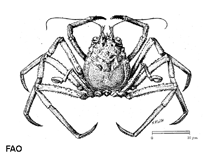Paromola cuvieri (Risso, 1816)
Paromola| Native range | All suitable habitat | Point map | Year 2050 |

|
| This map was computer-generated and has not yet been reviewed. |
| Paromola cuvieri AquaMaps Data sources: GBIF OBIS |
Classification / Names Common names | Synonyms | CoL | ITIS | WoRMS
| Decapoda | Homolidae
Environment: milieu / climate zone / depth range / distribution range Ecologia
; distribuzione batimetrica 10 - 1212 m (Ref. 435), usually 80 - 350 m (Ref. 435). Temperate; 64°N - 36°S, 34°W - 29°E
Distribuzione Stati | Aree FAO | Ecosystems | Presenze | Introduzioni
Eastern Atlantic and the Mediterranean: from Morocco to Angola and off lying islands, northwards to Hebrides and Southwest Norway, also in Mediterranean as far as Greece.
Length at first maturity / Size / Peso / Age
Maturity: Lm 7.2 range ? - ? cm Max length : 21.5 cm CL maschio/sesso non determinato; (Ref. 435)
Maximum depth from Ref. 106053. In bathyal oceanic communities (Ref. 96584). Occurs at depths from 10 to 1000 m, common at depths of 80 to 350 m (Ref. 435). Deep-water species, recorded down to 1212 m. Found in the shelf (Ref. 105470), upper and middle slope (Ref. 96584). where it is abundant in the latter (Ref. 96584). Prefers intermixed bathyal mud and emerging rocky substrates. Reported to be among cold-water coral community, specifically on coral mounds and coral habitats on muddy bottoms (Ref. 96584). Also found on seamounts (Ref. 122979). Carries a sponge on its back with its fifth pereiopods. Predator of benthic decapods (Ref. 96584) and an active scavenger (Refs. 96584, 106053).
Life cycle and mating behavior Maturità | Riproduzione | Deposizione | Uova | Fecundity | Larve
Members of the order Decapoda are mostly gonochoric. Mating behavior: Precopulatory courtship ritual is common (through olfactory and tactile cues); usually indirect sperm transfer.
Main reference
Bibliografia | Coordinatore | Collaboratori
Fischer, W., G. Bianchi and W.B. Scott (eds.). 1981. (Ref. 435)
IUCN Red List Status (Ref. 130435)
CITES status (Ref. 108899)
Not Evaluated
CMS (Ref. 116361)
Not Evaluated
Threat to humans
Human uses
Pesca: commerciale
| FishSource |
Strumenti
Informazioni ulteriori
Fonti Internet
BHL | BOLD Systems | CISTI | DiscoverLife | FAO(Publication : search) | Fishipedia | GenBank (genome, nucleotide) | GloBI | Gomexsi | Google Books | Google Scholar | Google | PubMed | Tree of Life | Wikipedia (Go, ricerca) | Zoological Record
Estimates based on models
Preferred temperature
(Ref. 115969): 10 - 16.4, mean 13.3 (based on 388 cells).
Resilienza
(Ref. 69278):
Alto, tempo minimo di raddoppiamento della popolazione meno di 15 mesi (Fec=217,000).
Price category
(Ref. 80766):
Unknown.



